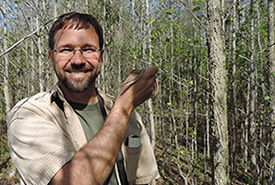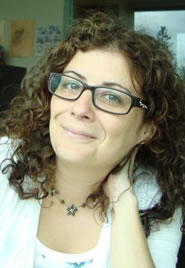The Maryland Biodiversity Project: Mobilizing community to build a better picture of local biodiversity

Wildlife photographer and naturalist Bill Hubick holds up an eastern ribbon snake (Photo courtesy of Bill Hubick)
A few years ago, photographer Bill Hubick generously donated the use of his photos on www.bilhubick.com in Nature Conservancy of Canada (NCC) publications. Since then, his images have been shared in NCC print publications and web pages across the country. We recently chatted with him about a new project he is also involved with — the Maryland Biodiversity Project.
CBT: What is the Maryland Biodiversity Project?
BH: The Maryland Biodiversity Project (MBP) is an effort to catalog all of the living things in Maryland. This includes everything from birds and mammals to insects, flowers, fungi and slime molds. We have cataloged nearly 14,000 species, including almost 5,000 with photos from about 300 contributors. In addition to creating an invaluable resource for Maryland naturalists, we work to promote nature education and conservation.
Our approach has been to build a community around compiling this resource and to get everyone excited about biodiversity. We hook people with beautiful photos and interesting facts, and then sprinkle in messages about conservation and the importance of biodiversity. We try to harness the community's momentum to promote nature study and conservation.
CBT: Who is the program run by and who is involved?
BH: My friend Jim Brighton and I created the project. We are both very active naturalists who have gone way down the rabbit hole after getting hooked by the gateway drug of birding. We both have day jobs, so much of our project is powered by caffeine and short nights of sleep. I am a web developer by trade, and Jim works in a boatyard on Maryland's Eastern Shore. We are in the process of incorporating as a 501c3 nonprofit, which will allow us to partner more formally with professional institutions. Our project is a community effort that depends on input from experts in the various biological domains. We have worked hard to earn the trust of the community and to partner with experts from many different fields. Hundreds of participants now contribute photos and records via our social media sites on Flickr, Facebook and Tumblr.
CBT: Why was the Maryland Biodiversity Project launched and what are your goals?
BH: We live in a time of unparalleled environmental change. How do we assess impacts if we don't have baseline data? State and federal agencies work tirelessly with limited resources to monitor just our rarest species. We need to monitor changes across the board for many reasons. First, it is far cheaper to manage for a given species when it is declining slightly than to wait until it requires a captive breeding program. Ecosystems are also complex, so trying to understand issues without information about what was present in the area five, 20, or 50 years ago is often impossible. Our ecosystems are like a game of Jenga, where removing one piece can cause the entirety to collapse.
Our initial goal was to create an invaluable resource for delving deeper and deeper into Maryland nature study. We wanted a place where you can see what birds have been found in Maryland, view great photos of each of them, and review which counties have records. Even more importantly, we wanted to do this for categories that are traditionally far less accessible — groups like crayfish, bees, ants, spiders, ferns, fungi, lichens...everything.
CBT: When was the project launched?
BH: The project kicked off just two years ago on Thursday (June 2012). Our progress has far exceeded even our ambitious goals for these two years. The longer we work on this project, the clearer it becomes that it is long overdue.
CBT: Is this a model that can be used by other conservation organizations elsewhere?
BH: Yes, but it's a lot of work. There are great citizen science efforts out there, and we are supporters of many of them. I am a Maryland reviewer for eBird, for example. However, we think the best model involves ground-up involvement of state and regional experts, mobilizing the community, mining of all available scientific papers and much more. We are interested in expanding this effort in the future, but we need about 10 hours added to the day. There might be some other more practical solutions, I suppose.
CBT: What lessons have you learned so far?
BH: Too many to list, but here's one that stands out. Expanding our horizons in nature study consistently deepens our enjoyment of the natural world. I am more excited about a few hours in the field now than I was 10 years ago, which I feel is the opposite of many people who specialize in one area. As a "county lister," I am slightly obsessed with seeing as many birds as possible in all of Maryland's 23 counties. After years of this wonderful pursuit, I can't count on finding a new "county bird" even in peak migration (though I love to try).
On the contrary — I can go on a walk with my two-year-old daughter Addy and find a new plant or insect nearly every time I leave the house. We can find interesting creatures anywhere we look, and chances are good that a species has not been formally documented in your area. I have added dozens of records that I believe are new for my county just around my house!
The closer you look, the more amazed you'll be. And we need to have a lot of people amazed and excited if we want to do a better job of protecting biodiversity!


